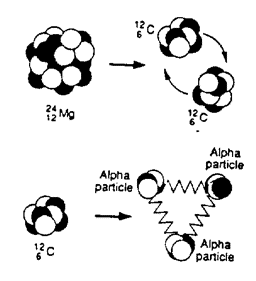 |
Science Frontiers ONLINE No. 76: Jul-Aug 1991 |
|
|
New Insights As To The Structure Of Matter
 Possible "nuclear-molecular" forms of magnesium-24 and carbon-12. |
Comment. Evidently we do not know everything about nuclear physics.
Beyond the molecule. We are used to seeing atoms and molecules arranging themselves into mathematically regular crystals. Now it appears that particles consisting of thousands of atoms also spontaneously organize themselves.
A.S. Edelstein et al find that molybdenum particles assemble themselves in cubes with two prominent edge lengths: 4.8 and 17.5 nanometers. The larger cubes show up in micrographs as 3x3x3 groupings of the smaller cubes. The smaller cubes each contain about 7000 atoms. (Edelstein, A.S., et al; "Self Arrangement of Molybdenum Particles into Cubes," Science, 251:1590, 1991.)
Comment. What are the "organizing forces" here? Why cubes? Why the heirarchy of cubes? Why 3x3x3 super cubes?